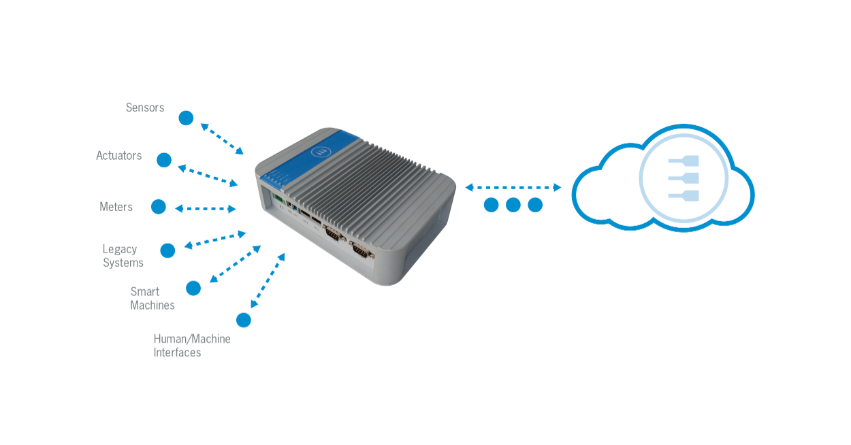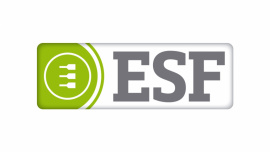
- Home
- related story
- How to simplify Industrial IoT application development with ESF Wires
June 19, 2020
How to simplify Industrial IoT application development with ESF Wires
The Industrial Internet of Things (IIoT) is meant to leverage hardware, software and cloud technologies and services to connect industrial machinery and edge devices to the cloud in order to collect, analyze and store data and integrate them with IT applications.
When it comes to IIoT application development, companies do not always have the expertise and knowledge of available frameworks, industrial protocols and programming languages to connect the OT (Operational Technology) infrastructure at the edge (where data are generated) and the IT (Information Technology) infrastructure in the data center/cloud (where data are "consumed" by applications).
An IoT Edge Framework like Everyware Software Framework (ESF) aims to simplify IIoT Edge Computing application development. Based on Java/OSGi open technologies, it helps turning edge devices into Multi-service IoT Edge Gateways that have edge computing capabilities and enable remote management, featuring APIs for integration with IT applications in the data center or on cloud platforms.
Building on proven architecture and software building blocks that would require many years to develop, the use of a Java-based IoT application framework will result in shorter and simplified IIoT application development.
ESF Wires is a feature incorporated in ESF that allows the visual composition of data pipelines - like shown in the picture below - that connect configurable logical components to build an Edge-to-Cloud IIoT Edge Computing application without writing the code from scratch.
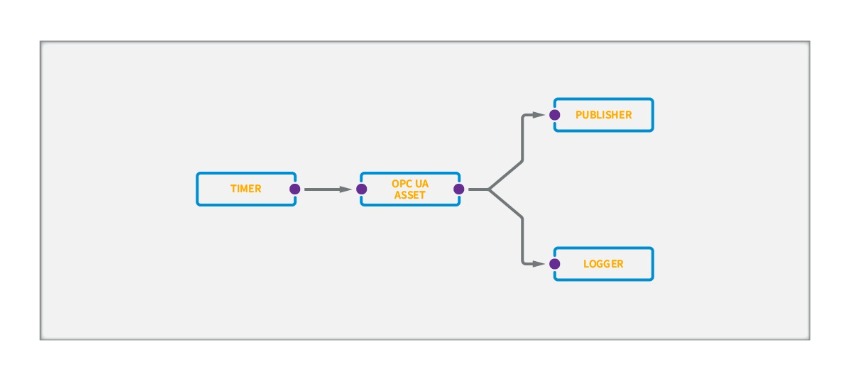
What is an IIoT application? The functional layers
Before digging into the details of the ESF Wires feature, it is necessary to understand what does it mean to develop an IIoT application, and what building blocks/components are required.
The IIoT aims to solve interoperability issues between field devices and protocols, combined with the need of IT applications to manage data in a secure way.
IIoT applications and architectures typically mix hardware, software and cloud technologies and services to connect the data collected by the “things” (sensors, devices, etc. typically deployed in the field or the OT world) with dashboards and applications managed by the IT. IIoT applications are sometimes very complex, but they can be split into four main layers.
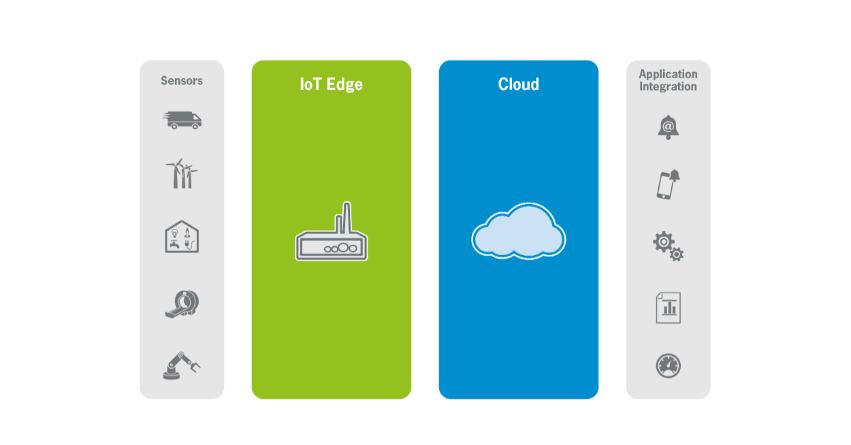
Sensors/devices
This layer includes all the sensors, actuators, PLCs and other devices that are connected with valuable assets in the field (such as machinery) and gather data from them. They are connected to intelligent devices (IoT gateways) which act as a bridge between IoT edge and cloud levels.
IoT Edge
The edge of an IoT application is where solutions connect, communicate and interact using sensors, actuators, gateways, agents and controllers.
As technology advances, vendors are touting advanced management and edge computing capabilities for these devices at the edge.
These capabilities vary, ranging from the simple ability to turn a device on and off to more complex actions such as updating software, managing Wi-Fi connections, configuring security policies or changing data parameters.
A device application framework puts a layer between the operating system and business applications on the IoT gateway.
This type of collection of cohesive software components lets customers modify, reconfigure and maintain their application over time, so it evolves as market demands change.
The adaptability and flexibility to meet market requirements will give customers a huge competitive advantage over static, fixed functionality agents.
Cloud
Data collected by gateways and devices in the field are stored in data centers or on cloud platforms for further analysis and integration with IT applications. The analysis process is aimed to simplify business decision making and can be aided by AI technologies.
Moreover, data are integrated into dashboards that help decision makers understand them more easily.
An example representing this layer is Everyware Cloud, an IoT Integration Platform that simplifies the remote management and monitoring of edge data and devices.
Application integration
Raw data are converted into actionable business insights by IT applications leveraging data science and analytics techniques and AI algorithms.
Enabling the seamless integration between OT data and enterprise IT is not an easy task, but it is the foundation of Industry 4.0 and the Fourth industrial revolution.
Business operations are improved and predictive maintenance helps to make production more efficient.
Simplify IIoT application development with Multi-service IoT Edge Gateways
IIoT application development and IIoT solution adoption can be a very complex task. All the layers mentioned above must be seamlessly integrated to provide a fast and secure data and device management from edge to cloud.
The IIoT environment is very fragmented, and there is a number of risks that company must face when adopting IIoT solutions. Read this blog post for a more detailed analysis on the risks of IoT adoption, here is a quick recap.
- Security: because of the lack of best practices, security could dramatically increase the cost of IoT projects and has the potential to scare users away from adopting IoT technologies.
- Lack of open standards and vendor lock-in: since there are many different devices, operating systems and programming languages employed on edge infrastructures, the lack of open standards represents a barrier for companies that would need to spend a lot of time and resources to choose the best products and solutions, that are typically tied to a specific vendor.
- Legacy equipment: connecting old/legacy equipment to the cloud is not an easy task, and employs a deep understanding of the OT industrial environment and protocols.
The Multi-Service IoT Edge Gateway approach is ideal to simplify IIoT application development. It is suited to connect edge devices to the business enterprise IT. It enables bidirectional communication between the field and the cloud and offers local processing and storage capabilities to provide offline services and near real-time device management and control.
IIoT adoption risks are reduced by using off-the-shelf, purpose-built devices to deliver solutions designed to meet vertical market value propositions. Data is delivered using a common protocol effectively decoupling data providers and data consumers, so the Multi-service IoT Edge Gateway approach provides design flexibility and the ability to future-proof investments by integrating and consolidating data streams.
The IoT Edge Framework ESF isolates the developer from the complexity of hardware, and networking sub-systems complement the IoT gateway hardware to form an integrated hardware and software solution.
Using this IT-centric approach to implement the device logic in smart edge devices offers a solid foundation for effective and secure data, device and embedded application management. Once this approach is in place, adding, changing and connecting sensors, actuators and essential local applications as well as connecting them to the cloud is simpler than it ever has been before.
ESF Wires: visual IIoT and Edge Computing application development
What is ESF Wires?
The ESF Wires is a feature of Eurotech ESF that enhances IoT Edge Gateways allowing simple and intuitive IIoT application development by wiring and connecting configurable components to build a dataflow programming model.
This is represented as a graph where each component (node) can have one or more inputs, outputs and its own processing logic. For example, industrial sensors or devices using different field protocols can connect to an IoT Edge Gateway, and their data filtered at the edge and sent to a cloud integration platform for further analysis.
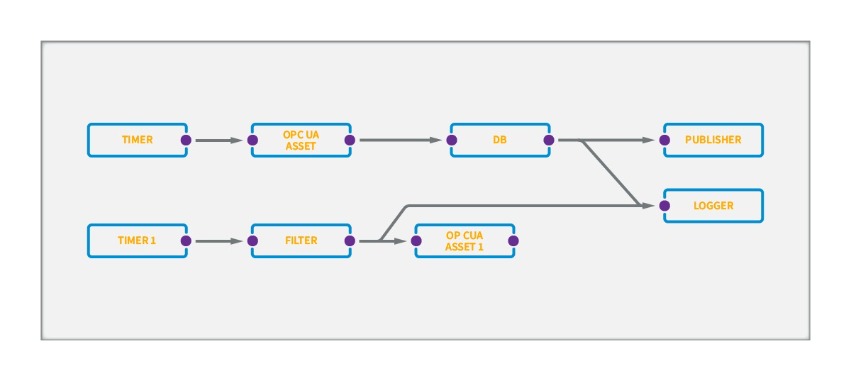
How does ESF Wires simplify IIoT and edge computing application development?
ESF Wires components can be downloaded from the Eclipse IoT Marketplace and be easily installed on ESF with a simple drag and drop. They are then put into a visual composer to design the dataflow graph.
There are components that can only produce outputs and inputs, and they usually represent the start and the end of the flow.
In between, other components process the input data and produce outputs for downstream nodes. This happens independently, without affecting the execution of other components. Thus, ESF Wires components are highly reusable and portable.
In this way, the developer can easily prototype its solution without sacrificing flexibility and working at a high level of abstraction: the graph is extendable through new nodes or drawing new connections. Furthermore, the developer can take advantage of Eclipse Marketplace integration, being able to use open source or commercial building blocks into the final solution, by simply dragging and dropping a link to the Eclipse Marketplace in the ESF Administrative Web UI.
How to build an IIoT application with drag and drop: ESF Wires components
The following are the main components used to develop IIoT Edge Computing applications:
- Timer: it triggers an event on the set period of time (usually starts the graph)
- Publisher: publishes data to a cloud platform
- DB Store: represents a database storage
- DB Filter: uses SQL queries to filter data residing in a database
- Logger: logs the messages locally
- Asset: configurable to communicate with a specific device according to the field protocol used (e.g. Modbus, OPC UA, S7, etc.)
A typical Industrial IoT application could be a series of PLCs connected to an IoT gateway sending machine status and production data to a cloud platform or a data center in a timely manner. In this case, we would have a Timer component sending periodically outputs to a Modbus Asset component (representing the PLC) which is connected to a cloud publisher.
Conclusions
We strongly believe that such visual dataflow programming approach will help users to focus more on their own application scenario rather than writing applications from scratch to do the same.
The ESF Wires really simplifies IIoT application development, and developers just need to focus on configuring the logical building blocks and wiring them together on a simple and user-friendly application interface.
